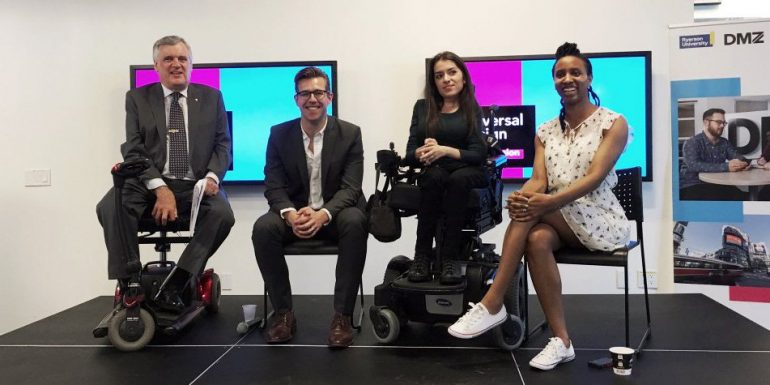These days, almost everyone owns a smartphone, and goes about their day swiping through their favourite apps on their way to work and home without a second thought. But what if technology — which is considered a powerful tool for marginalized groups to communicate and express themselves — isn’t designed in a way that includes everyone?
At the DMZ, the Universal Design session focused on how to remove barriers for people who aren’t considered the “average” user, and how design can impact social and mental well-being. The panel included Maayan Ziv, founder of AccessNow; Nadia Hamilton, founder of Magnusmode; and Jon Loewen, design leader at Perkins + Will Toronto.
“As time has moved on, we’re changing our definitions and new definitions are coming into play to better describe the modern reality that we live with and experience, and that is where we’re at today when it comes to the concept of universal design,” said David Onley, Special Advisor on Accessibility to the Minister of Economic Development, Employment and Infrastructure. Onley moderated the panel.
“In our work we tend to think about the difference between accessibility and universal design — there’s a difference in scope and intent. But it’s really about the difference between accommodation versus inclusion,” said Loewen. “That means making sure access isn’t constrained by physical reasons and we’re not denying people opportunities to participate due to cognitive issues, mental health, or socioeconomic marginalization.”
Ziv said that, as of recent, there’s been more awareness around the importance of diversity, which also encompasses recognizing disability. “I think there’s been a recent trend towards recognizing the power of diversity overall. Regardless of disability, there’s strength in bringing other perspectives to the table,” said Ziv. “So whether that’s you being a business owner or creating an event, there’s been a lot more focus — and definitely in the media — on the importance of diversity. And I think inclusion is a big part of that.”
Drawing on Ziv’s point, Hamilton said that it’s important to include all segments of the population that you’re designing for.
“I think that the more that you engage and ask questions and get feedback around what their needs are, the more accessible the finished product will be,” said Hamilton, who has a brother with Autism. “I was lucky that I spent 20+ years with my brother’s experience, but also worked in the community with others affected by a variety of needs and challenges, and I was able to engage them in the process of building our tool.”
Watch the entire talk below:
Photo credit @AccessNow


